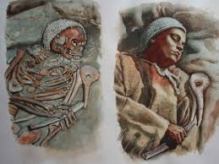How agriculture grew on us
The Neolithic revolution was neither Neolithic, nor a revolution.
— Colin Tudge
Human beings of the race that calls itself Homo sapiens lived in relative equality, in small foraging bands all its existence from the time they emerged about 200,000 years ago. Then, around 30,000 years ago, during a bit more clement time within the last ice age, glimmerings of inequality arose at sites known in Europe — in places that were unusually plentiful in game.
Tools grew more elaborate, trade widened, grave goods accompanied certain burials, jewelry and other prestige items became notable, and evidence of control over significant labor was in evidence (viz, for example, the stupendous numbers of sewn-on ivory beads in the Sungirgraves).
It has been hypothesized that at some locations, the fabled painted caves in France and Spain turned into places where elite children underwent their initiations. But when game grew sparse, humans went back to tight egalitarian cooperation.
Significant inequality kicked off around 15,000 years ago, after the end of the ice age, during the Magdalenian culture. By now, the dog, horse, and possibly the reindeer had been tamed by these stone-age foragers, thousands of years before the domestication of plants. The delicious pig was bred, also by foragers, in Anatolia about 13,000 years ago, while their Syrian neighbors may have tinkered with rye. A couple of millennia later, foragers built the impressive ceremonial center of Göbekli Tepe which shows the command of vast labor pools, not only to build the center, but eventually to bury it under a hill of gravel.
…click on the above link to read the rest of the article…
